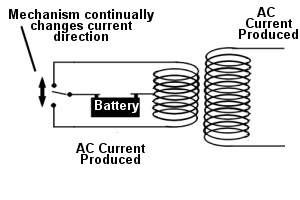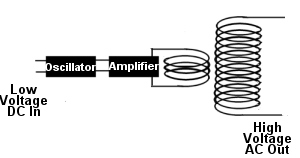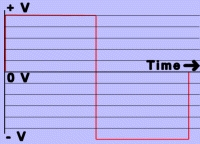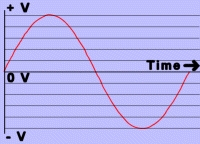Unless you have a basic system that offers a low-voltage DC power source, the inclusion of an inverter becomes essential. An inverter takes input from a DC (direct current) power supply and generates an AC (alternating current) output, typically at a voltage comparable to that of your standard mains supply. Essentially, it allows you to operate household appliances using a low-voltage DC source, such as a car battery or a more advanced solar power system.
How Does an Inverter Work?
To understand how an inverter accomplishes the transformation from low voltage direct current (DC) to high voltage alternating current (AC), let's draw parallels with the principle behind an alternator. In its most basic configuration, an alternator consists of a coil of wire near a rotating magnet. As one pole of the magnet approaches the coil, it induces a current in the coil. This current reaches its maximum as the magnet passes closest to the coil and then diminishes as the magnet moves away. However, when the opposite pole of the magnet nears the coil, the induced current flows in the opposite direction. The continual rotation of the magnet causes this process to repeat, resulting in the generation of an alternating current.

Similarly, an inverter operates by taking a low voltage DC input and employs electronic circuits to produce a simulated AC output. This simulated AC mimics the characteristics of the standard alternating current found in household power supplies. Through the inverter's controlled switching of electronic components, it effectively emulates the alternating pattern of an AC waveform, enabling the utilization of household appliances designed to run on AC power.
Considering the function of a transformer, it induces an electric current in a coil by utilizing the changing magnetic field generated by another coil with an alternating current flowing through it. Any coil carrying an electric current acts as a magnet, creating a magnetic field. When the direction of the current changes, the polarity of the field also changes.
The advantage of a transformer lies in its ability to alter the voltage in the secondary coil independently of the voltage applied to the primary coil. By adjusting the size of the coils, specifically by increasing the number of turns in the secondary coil relative to the primary coil, it's possible to generate a secondary voltage that is proportional to the ratio of the turns in the coils. For instance, if the secondary coil has twice the number of turns as the primary coil, the secondary voltage will be twice that of the voltage applied to the primary coil. This flexibility allows for the effective production of various voltages by manipulating the size of the coils in the transformer.

When a direct current is connected to the primary coil of a transformer, it fails to induce a current in the secondary coil because the magnetic field remains constant. However, by ingeniously causing the direct current to alternately change direction repetitively, a rudimentary inverter is created. This simple inverter generates a square wave output due to the abrupt changes in the current direction.

Certainly, this kind of inverter, employing the basic principle of changing the direction of current, might have been employed in early car radios. These radios needed to convert the 12 volts available in the car into higher voltages necessary to operate radio valves (also known as tubes in America), especially in the era before transistors became widely used.
As technology advanced, more sophisticated inverters emerged, leveraging transistors for the switching process. In such a setup, the switching transistors are likely to handle a small current, which is then amplified by additional transistor circuitry. Despite these advancements, the output waveform of this type of inverter remains a square wave.
Sine Wave Inverter
In order to obtain a sinusoidal alternating current from the transformer output, an oscillator is essential. To achieve this, a transistor can be configured to oscillate by introducing positive feedback, where a portion of the amplified output is fed back to the input. This phenomenon is commonly experienced in sound systems, such as PA or microphone setups, where proximity between the microphone and speaker can lead to feedback, resulting in a howling sound.
The positive feedback in an electronic circuit can be finely tuned using additional components to generate the desired frequency, typically around 50 or 60 cycles per second to mimic mains electricity. When a crystal is employed to control this frequency, as seen in battery-powered watches or clocks, the precision of the frequency can be highly controlled.
Similar to a simpler switching transistor circuit, the oscillator initially produces a low-current output. Subsequently, this output needs amplification, akin to a powerful audio amplifier, to generate the high current required for the primary coil of the transformer. It's worth noting that the frequency of mains AC is roughly comparable to the lowest notes on a bass guitar.

The transformer, while being very useful, does not do something for nothing. While it elevates the voltage, it concurrently diminishes the current, and the overall power (voltage x current) remains constant (discounting any transformer inefficiency). Essentially, to extract 1 kW of high-voltage AC current, you must input 1 kW of low-voltage AC current.
Grid-tied Inverter
If the above example were a grid-tied inverter, capable of feeding power back into the national grid, it would have to utilize a sample of the mains voltage. This sample would then be either amplified within the inverter or used to synchronize the oscillator.
Additionally, grid-tied inverters are equipped with the ability to detect a "power cut" and autonomously disconnect from the grid. This safety feature is crucial because without it, during a power outage, the inverter could inadvertently attempt to supply power to neighboring houses, posing an electrocution risk to individuals working on power lines that are believed to be deactivated.
How to Choose an Inverter For Your Solar Power System?
Main Inverter Types
- Square wave or modified sine wave.
- Sine wave (sometimes described as "Pure Sine wave")
- Grid-Tied
The square wave form will be as shown above right and the modified sine wave form will have had some attempt to round the corners off though will still have some sharp corners or spikes. This can be compared to the sine wave form displayed below on the right.
Compare this to the sine waveform below.
Many AC appliances function well with a modified sine wave form. Devices like computers, televisions, radios, or music centers often incorporate built-in power supplies that not only reduce voltage but also rectify it to generate a DC current, smoothing it for a consistent DC voltage. This rectification process typically mitigates any irregularities present in the original AC supply.
However, challenges arise with inductive loads, where power passes through a coil, such as in power supply transformers or motors. In these cases, the voltage and current become out of phase, leading to an inefficiency in modified sine wave inverters. This inefficiency can result in increased power consumption, causing the motor or transformer to run hotter and potentially reducing its lifespan.
Additionally, using a modified sine wave inverter may necessitate a slightly higher power rating to run the same appliance. There's also the risk of compromised performance, with potential issues such as suboptimal television picture quality and incorrect speed in appliances with timers, like a bread maker.
Furthermore, noise problems may arise. Equipment that produces a subtle hum when connected to the mains supply might generate a more bothersome buzz when connected to a modified sine wave inverter. Personal experience, particularly with a ceiling fan running at lower speeds, has revealed this potential issue. Evaluating these potential problems against the cost difference (modified sine wave converters being notably more affordable than pure sine wave converters) becomes crucial, considering the specific appliances you intend to use.
Grid-Tied
A grid-tied inverter possesses the capability to synchronize its sine wave output with an existing mains electricity supply, aligning its peak voltage with that of the mains supply. This type of inverter, when permitted by your electricity utility company and equipped with a modified meter if necessary, allows you to feed excess electricity into the grid system. In certain instances, your regular electricity meter may function in reverse when you are supplying power. A grid-tied inverter specifically designed for use without a battery (and consequently without a charge controller) might incorporate MPPT technology within its input circuitry.
String Inverters
Inverters crafted to handle elevated input voltages, reaching up to 600 volts in commercial systems, are commonly known as String Inverters. This nomenclature originates from the arrangement of connected panels, resembling a string, which collectively generates the higher voltages required.
DC Input Voltage
You may already have the rest of your system set up and you are already committed to using a particular voltage. You may however still be able to choose.
The lower the input voltage you are using, the higher the current you will need to use. For instance, if you compare a 12V and a 24V inverter with the same power rating, the 12V unit will need to draw twice the current. Correspondingly, the cables running from your battery to the inverter will need to be four times larger to accommodate this increased current.
While most inverters available in the market are either 12 or 24 volts, it's worth noting that a higher voltage system is likely to offer greater efficiency. The 48 volt inverter, although potentially more efficient, might be less common and, as a result, could be more expensive and harder to find.
AC Output Power
Every inverter comes with a specified output power, indicating the maximum continuous power it can deliver, typically measured in watts or kilowatts. In addition to this continuous power rating, inverters are designed to handle higher power levels for brief durations, accommodating the momentary power surges that occur when appliances are switched on. Nearly all electrical devices exhibit a momentary increase in current at startup, including low-energy light bulbs.
The power output characteristics can vary among different inverters, but they may have capabilities like producing 10% above the rated figure for 5 minutes, 50% over for 5 seconds, and even more for 1 second.
The continuous output power of any inverter can be influenced by the battery providing the DC input voltage. The battery must be sufficiently large to supply the high current required by a sizable inverter without causing the battery voltage to drop excessively low, which could lead to the inverter shutting down.
Ambient temperature is another factor that may affect the continuous output power capabilities of an inverter. High-power inverters generate heat, typically managed by a fan. In elevated temperatures, an inverter might struggle to sustain continuous high outputs without overheating and triggering an automatic shutdown.
How Much of Your DC Power Comes Out as AC Power?
The efficiency of an inverter refers to the percentage of input power that is converted into usable AC current, acknowledging that no system is 100% efficient and there will always be some losses. This efficiency varies based on the power demand, generally peaking when higher power levels are utilized.
Efficiency typically ranges from just over 50% at low power consumption to over 90% as the output approaches the inverter's rated capacity. Even when no AC power is drawn, an inverter may still draw some power from the batteries, resulting in lower efficiencies at low power levels.
For instance, a 3kW inverter might draw around 20 watts from the batteries when no AC current is used. If 20 watts of AC power is utilized, the inverter would draw 40 watts from the batteries, resulting in an efficiency of only 50%. Conversely, a smaller 200W inverter might draw 25 watts from the battery to produce a 20-watt AC output, achieving an efficiency of 80%.
Larger inverters often incorporate a "Sleep Mode" feature to enhance overall efficiency. This involves a sensor within the inverter determining the need for AC power. If not required, it effectively turns the inverter off, ready to switch back on when power is needed. However, this means appliances cannot be left in "standby" mode, and some devices with timers may struggle to draw enough power to keep the inverter engaged unless paired with another active load.
The wave form also plays a crucial role, especially with inductive loads (appliances with electrical coils, including those with motors). Non-sine waveforms, like square or modified square waves, are less efficient with inductive loads, potentially resulting in a 20% increase in power consumption compared to using a pure sine wave. This not only diminishes efficiency but may also lead to appliance damage or a shortened lifespan due to overheating.
Application Places of Micro Inverter
In the conventional setup of a solar power system, many solar panels or modules are typically connected to a centralized inverter that generates AC current at "mains" or "grid" voltage. This inverter not only converts DC current from the modules to AC but also manages the efficiency of the entire array. While an MPPT inverter can efficiently perform this task, it requires all modules to have uniform characteristics and operate under similar conditions. Microinverters, on the other hand, are compact inverters specifically designed to match individual solar panels or modules, offering several potential advantages.
Advantages
- Enhanced Reliability: With a system featuring a larger number of smaller inverters, the failure of one inverter results in the loss of power output from only one panel, contributing to overall system reliability.
- Optimized Efficiency: Micro inverters, each employing MPPT design, can precisely match the output of individual solar modules. This capability allows them to accommodate differences between modules caused by factors like aging, shading, temperature variations, or cleanliness, without requiring bypass diodes.
- Improved Monitoring Data: Each micro inverter can provide valuable information for every solar module, facilitating the monitoring of module conditions, cleanliness, and other relevant parameters.
- Greater Design Flexibility: The design of wiring is simplified, resulting in lower costs due to reduced currents. Additionally, expanding the system is made simpler with microinverters.

